ZHCSDW3B June 2015 – August 2016 TMP461
PRODUCTION DATA.
- 1 特性
- 2 应用
- 3 说明
- 4 简化框图
- 5 修订历史记录
- 6 Pin Configuration and Functions
- 7 Specifications
-
8 Detailed Description
- 8.1 Overview
- 8.2 Functional Block Diagram
- 8.3 Feature Description
- 8.4 Device Functional Modes
- 8.5 Programming
- 8.6
Register Map
- 8.6.1
Register Information
- 8.6.1.1 Pointer Register
- 8.6.1.2 Local and Remote Temperature Registers
- 8.6.1.3 Status Register
- 8.6.1.4 Configuration Register
- 8.6.1.5 Conversion Rate Register
- 8.6.1.6 One-Shot Start Register
- 8.6.1.7 Channel Enable Register
- 8.6.1.8 Consecutive ALERT Register
- 8.6.1.9 η-Factor Correction Register
- 8.6.1.10 Remote Temperature Offset Register
- 8.6.1.11 Manufacturer Identification Register
- 8.6.1
Register Information
- 9 Application and Implementation
- 10Power Supply Recommendations
- 11Layout
- 12器件和文档支持
- 13机械、封装和可订购信息
8 Detailed Description
8.1 Overview
The TMP461 device is a digital temperature sensor that combines a local temperature measurement channel and a remote-junction temperature measurement channel in a single WQFN-10 package. The device is two-wire- and SMBus-interface-compatible with nine pin-programmable bus address options, and is specified over a temperature range of –40°C to 125°C. The TMP461 device also contains multiple registers for programming and holding configuration settings, temperature limits, and temperature measurement results.
8.2 Functional Block Diagram
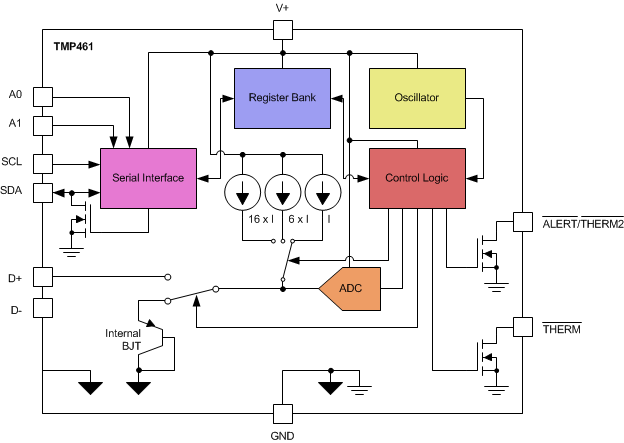
8.3 Feature Description
8.3.1 Temperature Measurement Data
The local and remote temperature sensors have a resolution of 12 bits (0.0625°C). Temperature data that result from conversions within the default measurement range are represented in binary form, as shown in the Standard Binary column of Table 1. Any temperatures above 127°C result in a value that rails to 127.9375 (7FFh). The device can be set to measure over an extended temperature range by changing bit 2 (RANGE) of the configuration register from low to high. The change in measurement range and data format from standard binary to extended binary occurs at the next temperature conversion. For data captured in the extended temperature range configuration, an offset of 64 (40h) is added to the standard binary value, as shown in the Extended Binary column of Table 1. This configuration allows measurement of temperatures as low as –64°C, and as high as 191°C; however, most temperature-sensing diodes only operate within the range of –55°C to 150°C. Additionally, the TMP461 is specified only for ambient temperatures ranging from –40°C to 125°C; parameters in the Absolute Maximum Ratings table must be observed.
Table 1. Temperature Data Format (Local and Remote Temperature High Bytes)
| TEMPERATURE (°C) |
LOCAL AND REMOTE TEMPERATURE REGISTER HIGH BYTE VALUE (1°C Resolution) |
|||
|---|---|---|---|---|
| STANDARD BINARY(1) | EXTENDED BINARY(2) | |||
| BINARY | HEX | BINARY | HEX | |
| –64 | 1100 0000 | C0 | 0000 0000 | 00 |
| –50 | 1100 1110 | CE | 0000 1110 | 0E |
| –25 | 1110 0111 | E7 | 0010 0111 | 27 |
| 0 | 0000 0000 | 00 | 0100 0000 | 40 |
| 1 | 0000 0001 | 01 | 0100 0001 | 41 |
| 5 | 0000 0101 | 05 | 0100 0101 | 45 |
| 10 | 0000 1010 | 0A | 0100 1010 | 4A |
| 25 | 0001 1001 | 19 | 0101 1001 | 59 |
| 50 | 0011 0010 | 32 | 0111 0010 | 72 |
| 75 | 0100 1011 | 4B | 1000 1011 | 8B |
| 100 | 0110 0100 | 64 | 1010 0100 | A4 |
| 125 | 0111 1101 | 7D | 1011 1101 | BD |
| 127 | 0111 1111 | 7F | 1011 1111 | BF |
| 150 | 0111 1111 | 7F | 1101 0110 | D6 |
| 175 | 0111 1111 | 7F | 1110 1111 | EF |
| 191 | 0111 1111 | 7F | 1111 1111 | FF |
Both local and remote temperature data use two bytes for data storage. The high byte stores the temperature with 1°C resolution. The second or low byte stores the decimal fraction value of the temperature and allows a higher measurement resolution, as shown in Table 2. The measurement resolution for both the local and the remote channels is 0.0625°C.
Table 2. Decimal Fraction Temperature Data Format (Local and Remote Temperature Low Bytes)
| TEMPERATURE (°C) |
TEMPERATURE REGISTER LOW BYTE VALUE (0.0625°C Resolution)(1) |
|
|---|---|---|
| STANDARD AND EXTENDED BINARY | HEX | |
| 0 | 0000 0000 | 00 |
| 0.0625 | 0001 0000 | 10 |
| 0.1250 | 0010 0000 | 20 |
| 0.1875 | 0011 0000 | 30 |
| 0.2500 | 0100 0000 | 40 |
| 0.3125 | 0101 0000 | 50 |
| 0.3750 | 0110 0000 | 60 |
| 0.4375 | 0111 0000 | 70 |
| 0.5000 | 1000 0000 | 80 |
| 0.5625 | 1001 0000 | 90 |
| 0.6250 | 1010 0000 | A0 |
| 0.6875 | 1011 0000 | B0 |
| 0.7500 | 1100 0000 | C0 |
| 0.8125 | 1101 0000 | D0 |
| 0.8750 | 1110 0000 | E0 |
| 0.9375 | 1111 0000 | F0 |
8.3.1.1 Standard Binary to Decimal Temperature Data Calculation Example
High-byte conversion (for example, 0111 0011):
Convert the right-justified binary high byte to hexadecimal.
From hexadecimal, multiply the first number by 160 = 1 and the second number by 161 = 16.
The sum equals the decimal equivalent.
0111 0011b → 73h → (3 × 160) + (7 × 161) = 115.
Low-byte conversion (for example, 0111 0000):
To convert the left-justified binary low-byte to decimal, use bits 7 through 4 and ignore bits 3 through 0 because they do not affect the value of the number.
0111b → (0 × 1 / 2)1 + (1 × 1 / 2)2 + (1 × 1 / 2)3 + (1 × 1 / 2)4 = 0.4375.
8.3.1.2 Standard Decimal to Binary Temperature Data Calculation Example
For positive temperatures (for example, 20°C):
(20°C) / (1°C per count) = 20 → 14h → 0001 0100.
Convert the number to binary code with 8-bit, right-justified format, and MSB = 0 to denote a positive sign.
20°C is stored as 0001 0100 → 14h.
For negative temperatures (for example, –20°C):
(|–20|) / (1°C per count) = 20 → 14h → 0001 0100.
Generate the twos complement of a negative number by complementing the absolute value binary number and adding 1.
–20°C is stored as 1110 1100 → ECh.
8.3.2 Series Resistance Cancellation
Series resistance cancellation automatically eliminates the temperature error caused by the resistance of the routing to the remote transistor or by the resistors of the optional external low-pass filter. A total of up to 1 kΩ of series resistance can be cancelled by the TMP461 device, thus eliminating the need for additional characterization and temperature offset correction. See Figure 5 (Remote Temperature Error vs Series Resistance) for details on the effects of series resistance on sensed remote temperature error.
8.3.3 Differential Input Capacitance
The TMP461 device tolerates differential input capacitance of up to 1000 pF with minimal change in temperature error. The effect of capacitance on the sensed remote temperature error is illustrated in Figure 6 (Remote Temperature Error vs Differential Capacitance).
8.3.4 Filtering
Remote junction temperature sensors are usually implemented in a noisy environment. Noise is most often created by fast digital signals that can corrupt measurements. The TMP461 device has a built-in, 65-kHz filter on the D+ and D– inputs to minimize the effects of noise. However, a bypass capacitor placed differentially across the inputs of the remote temperature sensor is recommended to make the application more robust against unwanted coupled signals. For this capacitor, select a value between 100 pF differential and 1 nF. Some applications attain better overall accuracy with additional series resistance. However, this increased accuracy is application-specific. When series resistance is added, the total value must not be greater than 1 kΩ. If filtering is required, suggested component values are 100 pF differential and 50 Ω on each input; exact values are application-specific.
Additionally, a digital filter is available for the remote temperature measurements to further reduce the effect of noise. This filter is programmable and has two levels when enabled. Level 1 performs a moving average of four consecutive samples. Level 1 filtering can be achieved by setting the digital filter control register (read address 24h, write address 24h) to 01h. Level 2 performs a moving average of eight consecutive samples. Level 2 filtering can be achieved by setting the digital filter control register (read address 24h, write address 24h) to 02h. The value stored in the remote temperature result register is the output of the digital filter, and is the value that the ALERT and THERM limits are compared to. The digital filter provides additional immunity to noise and spikes on the ALERT and THERM outputs. The filter responses to impulse and step inputs are shown in Figure 11 and Figure 12, respectively. The filter can be enabled or disabled by programming the desired levels in the digital filter register; see Table 4. The digital filter is disabled by default and on POR.
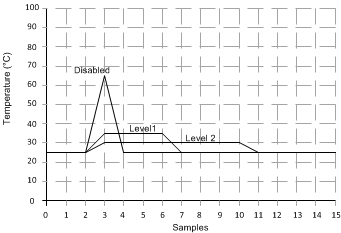
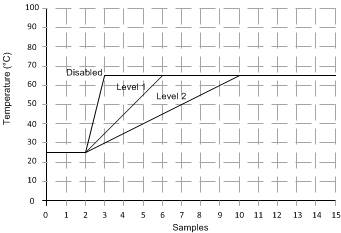
8.3.5 Sensor Fault
The TMP461 device can sense a fault at the D+ input resulting from an incorrect diode connection. The TMP461 device can also sense an open circuit. Short-circuit conditions return a value of –64°C. The detection circuitry consists of a voltage comparator that trips when the voltage at D+ exceeds (V+) – 0.3 V (typical). The comparator output is continuously checked during a conversion. If a fault is detected, then OPEN (bit 2) in the status register is set to 1.
When not using the remote sensor with the TMP461 device, the D+ and D– inputs must be connected together to prevent meaningless fault warnings.
8.3.6 ALERT and THERM Functions
Operation of the ALERT (pin 7) and THERM (pin 4) interrupts is shown in Figure 13. Operation of the THERM (pin 4) and THERM2 (pin 7) interrupts is shown in Figure 14. The ALERT and THERM pin setting is determined by bit 5 of the configuration register.
The hysteresis value is stored in the THERM hysteresis register and applies to both the THERM and THERM2 interrupts. The value of the CONAL[2:0] bits in the consecutive ALERT register (see Table 4) determines the number of limit violations before the ALERT pin is tripped. The default value is 000b and corresponds to one violation, 001b programs two consecutive violations, 011b programs three consecutive violations, and 111b programs four consecutive violations. The CONAL[2:0] bits provide additional filtering for the ALERT pin state.
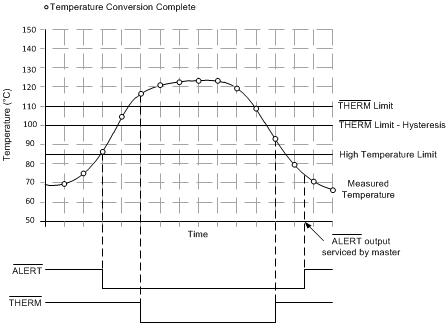
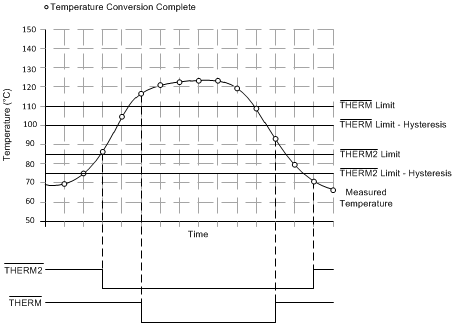
8.4 Device Functional Modes
8.4.1 Shutdown Mode (SD)
The TMP461 shutdown mode enables the user to save maximum power by shutting down all device circuitry other than the serial interface, and reducing current consumption to typically less than 3 μA; see Figure 10 (Shutdown Quiescent Current vs Supply Voltage). Shutdown mode is enabled when the SD bit (bit 6) of the configuration register is high; the device shuts down after the current conversion is finished. When the SD bit is low, the device maintains a continuous-conversion state.
8.5 Programming
8.5.1 Serial Interface
The TMP461 device operates only as a slave device on either the two-wire bus or the SMBus. Connections to either bus are made using the open-drain I/O lines, SDA and SCL. The SDA and SCL pins feature integrated spike suppression filters and Schmitt triggers to minimize the effects of input spikes and bus noise. The TMP461 device supports the transmission protocol for fast (1 kHz to 400 kHz) and high-speed (1 kHz to 2.17 MHz) modes. All data bytes are transmitted MSB first.
8.5.1.1 Bus Overview
The TMP461 device is SMBus-interface-compatible. In SMBus protocol, the device that initiates the transfer is called a master, and the devices controlled by the master are slaves. The bus must be controlled by a master device that generates the serial clock (SCL), controls the bus access, and generates the start and stop conditions.
To address a specific device, a start condition is initiated. A start condition is indicated by pulling the data line (SDA) from a high-to-low logic level when SCL is high. All slaves on the bus shift in the slave address byte, with the last bit indicating whether a read or write operation is intended. During the ninth clock pulse, the slave being addressed responds to the master by generating an acknowledge bit and pulling SDA low.
Data transfer is then initiated and sent over eight clock pulses followed by an acknowledge bit. During data transfer, SDA must remain stable when SCL is high. A change in SDA when SCL is high is interpreted as a control signal.
After all data are transferred, the master generates a stop condition. A stop condition is indicated by pulling SDA from low to high when SCL is high.
8.5.1.2 Bus Definitions
The TMP461 device is two-wire- and SMBus-compatible. Figure 15 and Figure 16 illustrate the timing for various operations on the TMP461 device. The bus definitions are as follows:
-
Bus Idle: Both SDA and SCL lines remain high.
-
Start Data Transfer: A change in the state of the SDA line (from high to low) when the SCL line is high defines a start condition. Each data transfer initiates with a start condition.
-
Stop Data Transfer: A change in the state of the SDA line (from low to high) when the SCL line is high defines a stop condition. Each data transfer terminates with a repeated start or stop condition.
-
Data Transfer: The number of data bytes transferred between a start and stop condition is not limited and is determined by the master device. The receiver acknowledges the data transfer.
-
Acknowledge: Each receiving device, when addressed, is obliged to generate an acknowledge bit. A device that acknowledges must pull down the SDA line during the acknowledge clock pulse in such a way that the SDA line is stable low during the high period of the acknowledge clock pulse. Take setup and hold times into account. On a master receive, data transfer termination can be signaled by the master generating a not-acknowledge on the last byte that is transmitted by the slave.
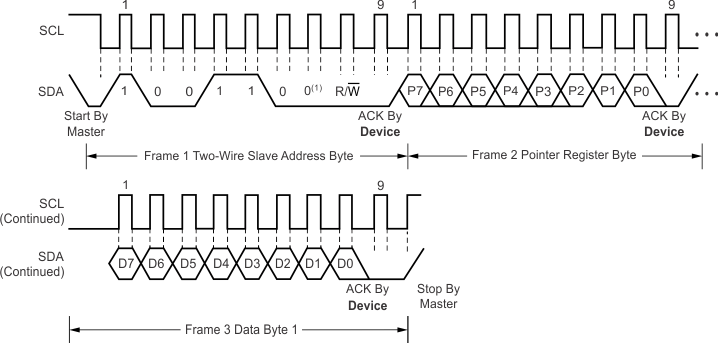
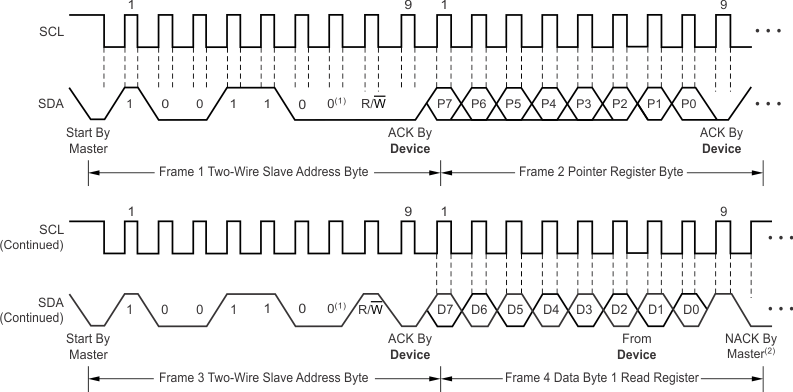
8.5.1.3 Serial Bus Address
To communicate with the TMP461 device, the master must first address slave devices using a slave address byte. The slave address byte consists of seven address bits and a direction bit indicating the intent of executing a read or write operation. The TMP461 allows up to nine devices to be connected to the SMBus, depending on the A0, A1 pin connections as described in Table 3. The A0 and A1 address pins must be isolated from noisy or high-frequency signals traces in order to avoid false address settings when these pins are set to a float state.
Table 3. TMP461 Slave Address Options
| A1 CONNECTION | A0 CONNECTION | SLAVE ADDRESS | |
|---|---|---|---|
| BINARY | HEX | ||
| GND | GND | 1001 000 | 48 |
| GND | Float | 1001 001 | 49 |
| GND | V+ | 1001 010 | 4A |
| Float | GND | 1001 011 | 4B |
| Float | Float | 1001 100 | 4C |
| Float | V+ | 1001 101 | 4D |
| V+ | GND | 1001 110 | 4E |
| V+ | Float | 1001 111 | 4F |
| V+ | V+ | 1010 000 | 50 |
8.5.1.4 Read and Write Operations
Accessing a particular register on the TMP461 device is accomplished by writing the appropriate value to the pointer register. The value for the pointer register is the first byte transferred after the slave address byte with the R/W bit low. Every write operation to the TMP461 device requires a value for the pointer register (see Figure 15).
When reading from the TMP461 device, the last value stored in the pointer register by a write operation is used to determine which register is read by a read operation. To change which register is read for a read operation, a new value must be written to the pointer register. This transaction is accomplished by issuing a slave address byte with the R/W bit low, followed by the pointer register byte; no additional data are required. The master can then generate a start condition and send the slave address byte with the R/W bit high to initiate the read command; see Figure 16 for details of this sequence.
If repeated reads from the same register are desired, continually sending the pointer register bytes is not necessary because the TMP461 retains the pointer register value until it is changed by the next write operation. The register bytes are sent MSB first, followed by the LSB.
Terminate read operations by issuing a not-acknowledge command at the end of the last byte to be read. For a single-byte operation, the master must leave the SDA line high during the acknowledge time of the first byte that is read from the slave.
8.5.1.5 Timeout Function
The TMP461 device resets the serial interface if either SCL or SDA are held low for 25 ms (typical) between a start and stop condition. If the TMP461 device is holding the bus low, the device releases the bus and waits for a start condition. To avoid activating the timeout function, maintaining a communication speed of at least 1 kHz for the SCL operating frequency is necessary.
8.5.1.6 High-Speed Mode
For the two-wire bus to operate at frequencies above 1 MHz, the master device must issue a high-speed mode (HS-mode) master code (0000 1xxx) as the first byte after a start condition to switch the bus to high-speed operation. The TMP461 device does not acknowledge this byte, but switches the input filters on SDA and SCL and the output filter on SDA to operate in HS-mode, thus allowing transfers at up to 2.17 MHz. After the HS-mode master code is issued, the master transmits a two-wire slave address to initiate a data transfer operation. The bus continues to operate in HS-mode until a stop condition occurs on the bus. Upon receiving the stop condition, the TMP461 device switches the input and output filters back to fast mode operation.
8.5.2 General-Call Reset
The TMP461 device supports reset using the two-wire general-call address 00h (0000 0000b). The TMP461 device acknowledges the general-call address and responds to the second byte. If the second byte is 06h (0000 0110b), the TMP461 device executes a software reset. This software reset restores the power-on reset state to all TMP461 registers and aborts any conversion in progress. The TMP461 device takes no action in response to other values in the second byte.
8.6 Register Map
Table 4. Register Map
| POINTER READ (HEX) | POINTER WRITE (HEX) | POR (HEX) | BIT DESCRIPTION | REGISTER DESCRIPTION | |||||||
|---|---|---|---|---|---|---|---|---|---|---|---|
| 7 | 6 | 5 | 4 | 3 | 2 | 1 | 0 | ||||
| 00 | N/A | 00 | LT11 | LT10 | LT9 | LT8 | LT7 | LT6 | LT5 | LT4 | Local Temperature Register (high byte) |
| 01 | N/A | 00 | RT11 | RT10 | RT9 | RT8 | RT7 | RT6 | RT5 | RT4 | Remote Temperature Register (high byte) |
| 02 | N/A | N/A | BUSY | LHIGH | LLOW | RHIGH | RLOW | OPEN | RTHRM | LTHRM | Status Register |
| 03 | 09 | 00 | MASK1 | SD | ALERT/THERM2 | 0 | 0 | RANGE | 0 | 0 | Configuration Register |
| 04 | 0A | 08 | 0 | 0 | 0 | 0 | CR3 | CR2 | CR1 | CR0 | Conversion Rate Register |
| 05 | 0B | 7F | LTHL11 | LTHL10 | LTHL9 | LTHL8 | LTHL7 | LTHL6 | LTHL5 | LTHL4 | Local Temperature High Limit Register |
| 06 | 0C | 80 | LTLL11 | LTLL10 | LTLL9 | LTLL8 | LTLL7 | LTLL6 | LTLL5 | LTLL4 | Local Temperature Low Limit Register |
| 07 | 0D | 7F | RTHL11 | RTHL10 | RTHL9 | RTHL8 | RTHL7 | RTHL6 | RTHL5 | RTHL4 | Remote Temperature High Limit Register (high byte) |
| 08 | 0E | 80 | RTLL11 | RTLL10 | RTLL9 | RTLL8 | RTLL7 | RTLL6 | RTLL5 | RTLL4 | Remote Temperature Low Limit Register (high byte) |
| N/A | 0F | N/A | X | X | X | X | X | X | X | X | One-Shot Start Register(1) |
| 10 | N/A | 00 | RT3 | RT2 | RT1 | RT0 | 0 | 0 | 0 | 0 | Remote Temperature Register (low byte) |
| 11 | 11 | 00 | RTOS11 | RTOS10 | RTOS9 | RTOS8 | RTOS7 | RTOS6 | RTOS5 | RTOS4 | Remote Temperature Offset Register (high byte) |
| 12 | 12 | 00 | RTOS3 | RTOS2 | RTOS1 | RTOS0 | 0 | 0 | 0 | 0 | Remote Temperature Offset Register (low byte) |
| 13 | 13 | F0 | RTHL3 | RTHL2 | RTHL1 | RTHL0 | 0 | 0 | 0 | 0 | Remote Temperature High Limit Register (low byte) |
| 14 | 14 | 00 | RTLL3 | RTLL2 | RTLL1 | RTLL0 | 0 | 0 | 0 | 0 | Remote Temperature Low Limit Register (low byte) |
| 15 | N/A | 00 | LT3 | LT2 | LT1 | LT0 | 0 | 0 | 0 | 0 | Local Temperature Register (low byte) |
| 16 | 16 | 03 | 0 | 0 | 0 | 0 | 0 | 0 | REN | LEN | Channel Enable Register |
| 19 | 19 | 7F | RTH11 | RTH10 | RTH9 | RTH8 | RTH7 | RTH6 | RTH5 | RTH4 | Remote Temperature THERM Limit Register |
| 20 | 20 | 7F | LTH11 | LTH10 | LTH9 | LTH8 | LTH7 | LTH6 | LTH5 | LTH4 | Local Temperature THERM Limit Register |
| 21 | 21 | 0A | HYS11 | HYS10 | HYS9 | HYS8 | HYS7 | HYS6 | HYS5 | HYS4 | THERM Hysteresis Register |
| 22 | 22 | 01 | 0 | 0 | 0 | 0 | CONAL2 | CONAL1 | CONAL0 | 1 | Consecutive ALERT Register |
| 23 | 23 | 00 | NC7 | NC6 | NC5 | NC4 | NC3 | NC2 | NC1 | NC0 | η-Factor Correction Register |
| 24 | 24 | 00 | 0 | 0 | 0 | 0 | 0 | 0 | DF1 | DF0 | Digital Filter Control Register |
| FE | N/A | 55 | 0 | 1 | 0 | 1 | 0 | 1 | 0 | 1 | Manufacturer Identification Register |
8.6.1 Register Information
The TMP461 device contains multiple registers for holding configuration information, temperature measurement results, and status information. These registers are described in Figure 17 and Table 4.
8.6.1.1 Pointer Register
Figure 17 shows the internal register structure of the TMP461 device. The 8-bit pointer register is used to address a given data register. The pointer register identifies which of the data registers must respond to a read or write command on the two-wire bus. This register is set with every write command. A write command must be issued to set the proper value in the pointer register before executing a read command. Table 4 describes the pointer register and the internal structure of the TMP461 registers. The power-on reset (POR) value of the pointer register is 00h (0000 0000b).
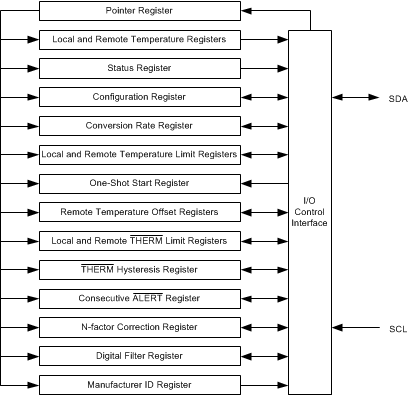 Figure 17. Internal Register Structure
Figure 17. Internal Register Structure
8.6.1.2 Local and Remote Temperature Registers
The TMP461 device has multiple 8-bit registers that hold temperature measurement results. The eight most significant bits (MSBs) of the local temperature sensor result are stored in register 00h, and the four least significant bits (LSBs) are stored in register 15h (the four MSBs of register 15h). The eight MSBs of the remote temperature sensor result are stored in register 01h, and the four LSBs are stored in register 10h (the four MSBs of register 10h). The four LSBs of both the local and remote sensor indicate the temperature value after the decimal point (for example, if the temperature result is 10.0625°C, then the high byte is 0000 1010 and the low byte is 0001 0000). These registers are read-only and are updated by the ADC each time a temperature measurement is completed.
When the full temperature value is needed, reading the MSB value first causes the LSB value to be locked (the ADC does not write to it) until the LSB value is read. The same thing happens upon reading the LSB value first (the MSB value is locked until it is read). This mechanism assures that both bytes of the read operation are from the same ADC conversion. This assurance remains valid only until another register is read. For proper operation, read the high byte of the temperature result first. Read the low byte register in the next read command; if the LSBs are not needed, the register can be left unread. The power-on reset value of all temperature registers is 00h.
8.6.1.3 Status Register
The status register reports the state of the temperature ADC, the temperature limit comparators, and the connection to the remote sensor. Table 5 lists the status register bits. The status register is read-only and is read by accessing pointer address 02h.
Table 5. Status Register Format
| STATUS REGISTER (Read = 02h, Write = N/A) | ||
|---|---|---|
| BIT NUMBER | BIT NAME | FUNCTION |
| 7 | BUSY | = 1 when the ADC is converting |
| 6 | LHIGH(1) | = 1 when the local high temperature limit is tripped |
| 5 | LLOW(1) | = 1 when the local low temperature limit is tripped |
| 4 | RHIGH(1) | = 1 when the remote high temperature limit is tripped |
| 3 | RLOW(1) | = 1 when the remote low temperature limit is tripped |
| 2 | OPEN(1) | = 1 when the remote sensor is an open circuit |
| 1 | RTHRM | = 1 when the remote THERM limit is tripped |
| 0 | LTHRM | = 1 when the local THERM limit is tripped |
The BUSY bit = 1 if the ADC is making a conversion. This bit is set to 0 if the ADC is not converting.
The LHIGH and LLOW bits indicate a local sensor overtemperature or undertemperature event, respectively. The RHIGH and RLOW bits indicate a remote sensor overtemperature or undertemperature event, respectively. The HIGH bit is set when the temperature exceeds the high limit in alert mode and therm mode and the low bit is set when the temperature goes below the low limit in alert mode. The OPEN bit indicates an open-circuit condition on the remote sensor. When pin 7 is configured as the ALERT output, the five flags are NORed together. If any of the five flags are high, the ALERT interrupt latch is set and the ALERT output goes low. Reading the status register clears the five flags, provided that the condition that caused the setting of the flags is not present anymore (that is, the value of the corresponding result register is within the limits, or the remote sensor is connected properly and functional). The ALERT interrupt latch (and the ALERT pin correspondingly) is not reset by reading the status register. The reset is done by the master reading the temperature sensor device address to service the interrupt, and only if the flags are reset and the condition that caused them to be set is no longer present.
The RTHRM and LTHRM flags are set when the corresponding temperature exceeds the programmed THERM limit. These flags are reset automatically when the temperature returns to within the limits. The THERM output goes low in the case of overtemperature on either the local or remote channel, and goes high as soon as the measurements are within the limits again. The THERM hysteresis register (21h) allows hysteresis to be added so that the flag resets and the output goes high when the temperature returns to or goes below the limit value minus the hysteresis value.
When pin 7 is configured as THERM2, only the high limits matter. The LHIGH and RHIGH flags are set if the respective temperatures exceed the limit values, and the pin goes low to indicate the event. The LLOW and RLOW flags have no effect on THERM2 and the output behaves the same way when configured as THERM.
8.6.1.4 Configuration Register
The configuration register sets the temperature range, the ALERT/THERM modes, and controls the shutdown mode. The configuration register is set by writing to pointer address 09h, and is read by reading from pointer address 03h. Table 6 summarizes the bits of the configuration register.
Table 6. Configuration Register Bit Descriptions
| CONFIGURATION REGISTER (Read = 03h, Write = 09h, POR = 00h) | |||
|---|---|---|---|
| BIT NUMBER | NAME | FUNCTION | POWER-ON RESET VALUE |
| 7 | MASK1 | 0 = ALERT enabled 1 = ALERT masked |
0 |
| 6 | SD | 0 = Run 1 = Shut down |
0 |
| 5 | ALERT/THERM2 | 0 = ALERT
1 = THERM2 |
0 |
| 4:3 | Reserved | — | 0 |
| 2 | RANGE | 0 = –40°C to +127°C 1 = –64°C to +191°C |
0 |
| 1:0 | Reserved | — | 0 |
MASK1 (bit 7) of the configuration register masks the ALERT output. If MASK1 is 0 (default), the ALERT output is enabled. If MASK1 is set to 1, the ALERT output is disabled. This configuration applies only if the value of ALERT/THERM2 (bit 5) is 0 (that is, pin 7 is configured as the ALERT output). If pin 7 is configured as the THERM2 output, the value of the MASK1 bit has no effect.
The shutdown bit (SD, bit 6) enables or disables the temperature-measurement circuitry. If SD = 0 (default), the TMP461 device converts continuously at the rate set in the conversion rate register. When SD is set to 1, the TMP461 device stops converting when the current conversion sequence is complete and enters a shutdown mode. When SD is set to 0 again, the TMP461 resumes continuous conversions. When SD = 1, a single conversion can be started by writing to the one-shot start register; see the One-Shot Start Register section for more information.
ALERT/THERM2 (bit 5) sets the configuration of pin 7. If the ALERT/THERM2 bit is 0 (default), then pin 7 is configured as the ALERT output; if this bit is set to 1, then pin 7 is configured as the THERM2 output.
The temperature range is set by configuring RANGE (bit 2) of the configuration register. Setting this bit low (default) configures the TMP461 device for the standard measurement range (–40°C to +127°C); temperature conversions are stored in the standard binary format. Setting bit 2 high configures the TMP461 device for the extended measurement range (–64°C to +191°C); temperature conversions are stored in the extended binary format (see Table 1).
The remaining bits of the configuration register are reserved and must always be set to 0. The power-on reset value for this register is 00h.
8.6.1.5 Conversion Rate Register
The conversion rate register (read address 04h, write address 0Ah) controls the rate at which temperature conversions are performed. This register adjusts the idle time between conversions but not the conversion time itself, thereby allowing the TMP461 power dissipation to be balanced with the temperature register update rate. Table 7 lists the conversion rate options and corresponding time between conversions. The default value of the register is 08h, which gives a default rate of 16 conversions per second.
Table 7. Conversion Rate
| VALUE | CONVERSIONS PER SECOND | TIME (Seconds) |
|---|---|---|
| 00h | 0.0625 | 16 |
| 01h | 0.125 | 8 |
| 02h | 0.25 | 4 |
| 03h | 0.5 | 2 |
| 04h | 1 | 1 |
| 05h | 2 | 0.5 |
| 06h | 4 | 0.25 |
| 07h | 8 | 0.125 |
| 08h | 16 (default) | 0.0625 (default) |
| 09h | 32 | 0.03125 |
8.6.1.6 One-Shot Start Register
When the TMP461 device is in shutdown mode (SD = 1 in the configuration register), a single conversion is started by writing any value to the one-shot start register, pointer address 0Fh. This write operation starts one conversion and comparison cycle on either both the local and remote sensors or on only one or the other sensor, depending on the LEN and REN values configured in the channel enable register (read address 16h, write address 16h). The TMP461 device returns to shutdown mode when the cycle completes. The value of the data sent in the write command is irrelevant and is not stored by the TMP461 device.
8.6.1.7 Channel Enable Register
The channel enable register (read address 16h, write address 16h) enables or disables the temperature conversion of remote and local temperature sensors. LEN (bit 0) of the channel enable register enables/disables the conversion of local temperature. REN (bit 1) of the channel enable register enables/disables the conversion of remote temperature. Both LEN and REN are set to 1 (default), this enables the ADC to convert both local and remote temperatures. If LEN is set to 0, the local temperature conversion is disabled and similarly if REN is set to 0, the remote temperature conversion is disabled.
Both local and remote temperatures are converted by the internal ADC as a default mode. Channel Enable register can be configured to achieve power savings by reducing the total ADC conversion time to half for applications that do not require both remote and local temperature information.
8.6.1.8 Consecutive ALERT Register
The Consecutive ALERT register (read address 22h, write address 22h) controls the number of out-of-limit temperature measurements required for ALERT to be asserted. Table 8 summarizes the values of the consecutive ALERT register. The number programmed in the consecutive ALERT applies to both the remote and local temperature results. When the number of times that the temperature result consecutively exceeds the high limit register value is equal to the value programmed in the consecutive ALERT register, ALERT is asserted. Similarly, the consecutive ALERT register setting is also applicable to the low-limit register.
Table 8. Consecutive ALERT
| REGISTER VALUE | NUMBER OF OUT-OF-LIMIT MEASUREMENTS REQUIRED TO ASSERT ALERT |
|---|---|
| 01h | 1 (default) |
| 03h | 2 |
| 07h | 3 |
| 0Fh | 4 |
8.6.1.9 η-Factor Correction Register
The TMP461 device allows for a different η-factor value to be used for converting remote channel measurements to temperature. The remote channel uses sequential current excitation to extract a differential VBE voltage measurement to determine the temperature of the remote transistor. Equation 1 shows this voltage and temperature.

The value η in Equation 1 is a characteristic of the particular transistor used for the remote channel. The power-on reset value for the TMP461 device is η = 1.008. The value in the η-factor correction register can be used to adjust the effective η-factor according to Equation 2 and Equation 3.


The η-factor correction value must be stored in twos complement format, yielding an effective data range from –128 to 127. The η-factor correction value is written to and read from pointer address 23h. The register power-on reset value is 00h, thus having no effect unless a different value is written to it. The resolution of the η-factor register is 0.000483.
Table 9. η-Factor Range
| NADJUST | η | ||
|---|---|---|---|
| BINARY | HEX | DECIMAL | |
| 0111 1111 | 7F | 127 | 0.950205 |
| 0000 1010 | 0A | 10 | 1.003195 |
| 0000 1000 | 08 | 8 | 1.004153 |
| 0000 0110 | 06 | 6 | 1.005112 |
| 0000 0100 | 04 | 4 | 1.006073 |
| 0000 0010 | 02 | 2 | 1.007035 |
| 0000 0001 | 01 | 1 | 1.007517 |
| 0000 0000 | 00 | 0 | 1.008 |
| 1111 1111 | FF | –1 | 1.008483 |
| 1111 1110 | FE | –2 | 1.008966 |
| 1111 1100 | FC | –4 | 1.009935 |
| 1111 1010 | FA | –6 | 1.010905 |
| 1111 1000 | F8 | –8 | 1.011877 |
| 1111 0110 | F6 | –10 | 1.012851 |
| 1000 0000 | 80 | –128 | 1.073829 |
8.6.1.10 Remote Temperature Offset Register
The offset register allows the TMP461 device to store any system offset compensation value that may result from precision calibration. The value in the register is stored in the same format as the temperature result, and is added to the remote temperature result upon every conversion. Combined with the η-factor correction, this function allows for very accurate system calibration over the entire temperature range.
8.6.1.11 Manufacturer Identification Register
The TMP461 device allows for the two-wire bus controller to query the device for manufacturer and device IDs to enable software identification of the device at the particular two-wire bus address. The manufacturer ID is obtained by reading from pointer address FEh. The TMP461 device reads 55h for the manufacturer code.